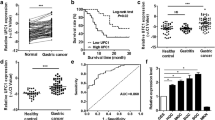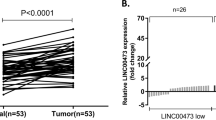Abstract
Gastric cancer (GC) is a common malignant tumor, posing a great threat to human’s health and life. Previous studies have suggested aberrant expression of long non-coding RNAs (lncRNAs) in GC. This study elucidated the effects of lncRNA ACTA2-AS1 on the biological characteristics of GC. Gene expression in stomach adenocarcinoma (STAD) samples compared with normal tissues and the correlation between gene expression and prognosis of STAD patients were analyzed using bioinformatic tools. Gene expression at protein and mRNA levels in GC and normal cells was tested by western blotting and RT-qPCR. The subcellular localization of ACTA2-AS1 in AGS and HGC27 cells was identified by nuclear-cytoplasmic fractionation and FISH assay. EdU, CCK-8, flow cytometry analysis, TUNEL staining assays were conducted to evaluate the role of ACTA2-AS1 and ESRRB on GC cellular behaviors. The binding relationship among ACTA2-AS1, miR-6720-5p and ESRRB was verified by RNA pulldown, luciferase reporter assay and RIP assay. LncRNA ACTA2-AS1 was underexpressed in GC tissues and cell lines. ACTA2-AS1 elevation suppressed GC cell proliferation and induced apoptosis. Mechanistically, ACTA2-AS1 directly bound to miR-6720-5p and subsequently promoted the expression of target gene ESRRB in GC cells. Furthermore, ESRRB knockdown reversed the influence of ACTA2-AS1 overexpression on GC proliferation and apoptosis. ACTA2-AS1 plays an antioncogenic role in GC via binding with miR-6720-5p to regulate ESRRB expression.






Similar content being viewed by others
Data Availability
The datasets used during the current study are available from the corresponding author on reasonable request.
References
Ang TL, Fock KM (2014) Clinical epidemiology of gastric cancer. Singapore Med J 55(12):621–628
Bhan A, Soleimani M, Mandal SS (2017) Long noncoding RNA and cancer: a new paradigm. Cancer Res 77(15):3965–3981
Bray F et al (2018) Global cancer statistics 2018: GLOBOCAN estimates of incidence and mortality worldwide for 36 cancers in 185 countries. CA Cancer J Clin 68(6):394–424
Cao J et al (2021) Long non-coding RNA-based signature for predicting prognosis of hepatocellular carcinoma. Bioengineered 12(1):673–681
Chen S et al (2021) Analysis of Collagen type X alpha 1 (COL10A1) expression and prognostic significance in gastric cancer based on bioinformatics. Bioengineered 12(1):127–137
Correa P (2013) Gastric cancer: overview. Gastroenterol Clin North Am 42(2):211–217
Cui Y et al (2020) LncRNA FAM230B promotes gastric cancer growth and metastasis by regulating the miR-27a-5p/TOP2A axis. Dig Dis Sci. https://doi.org/10.1007/s10620-020-06581-z
Deng P et al (2021) LINC00242/miR-1-3p/G6PD axis regulates Warburg effect and affects gastric cancer proliferation and apoptosis. Mol Med 27(1):9
Ding X et al (2021) Muscleblind-like 1 antisense RNA 1 inhibits cell proliferation, invasion, and migration of prostate cancer by sponging miR-181a-5p and regulating PTEN/PI3K/AKT/mTOR signaling. Bioengineered 12(1):803–814
Fan R et al (2020) Wnt/Beta-catenin/Esrrb signalling controls the tissue-scale reorganization and maintenance of the pluripotent lineage during murine embryonic diapause. Nat Commun 11(1):5499
Fernandez AI et al (2020) The orphan nuclear receptor estrogen-related receptor beta (ERRβ) in triple-negative breast cancer. Breast Cancer Res Treat 179(3):585–604
Gallagher KM et al (2020) ESRRB regulates glucocorticoid gene expression in mice and patients with acute lymphoblastic leukemia. Blood Adv 4(13):3154–3168
Giguère V et al (1988) Identification of a new class of steroid hormone receptors. Nature 331(6151):91–94
Guggenheim DE, Shah MA (2013) Gastric cancer epidemiology and risk factors. J Surg Oncol 107(3):230–236
Han D et al (2017) Circular RNA circMTO1 acts as the sponge of microRNA-9 to suppress hepatocellular carcinoma progression. Hepatology 66(4):1151–1164
Hirschenberger M et al (2021) Luciferase reporter assays to monitor interferon signaling modulation by SARS-CoV-2 proteins. STAR Protoc 2(4):100781
Jian F et al (2021) The long-noncoding RNA SOCS2-AS1 suppresses endometrial cancer progression by regulating AURKA degradation. Cell Death Dis 12(4):351
Johnston FM, Beckman M (2019) Updates on management of gastric cancer. Curr Oncol Rep 21(8):67
Karimi P et al (2014) Gastric cancer: descriptive epidemiology, risk factors, screening, and prevention. Cancer Epidemiol Biomarkers Prev 23(5):700–713
Li G et al (2020) Identification of a three-miRNA signature as a novel prognostic model for papillary renal cell carcinoma. Cancer Cell Int 20:317
Li Q et al (2021) Alterations of long non-coding RNA and mRNA profiles associated with extracellular matrix homeostasis and vascular aging in rats. Bioengineered 12(1):832–843
Liang LC et al (2021) Long non-coding RNA BX357664 inhibits gastric cancer progression by sponging miR-183a-3p to regulate the PTEN expression and PI3K/AKT pathway. Food Chem Toxicol 150:112069
Lin C et al (2022) Knockdown of lncRNA ACTA2-AS1 reverses cisplatin resistance of ovarian cancer cells via inhibition of miR-378a-3p-regulated Wnt5a. Bioengineered 13(4):9829–9838
Liu XH et al (2014) Lnc RNA HOTAIR functions as a competing endogenous RNA to regulate HER2 expression by sponging miR-331-3p in gastric cancer. Mol Cancer 13:92
Liu Z et al (2022) lncRNA ACTA2-AS1 inhibits malignant phenotypes of gastric cancer cells. Open Med 17(1):266–279
Lu Y et al (2015) Messenger RNA profile analysis deciphers new Esrrb responsive genes in prostate cancer cells. BMC Mol Biol 16:21
Luo L et al (2020) A novel mechanism by which ACTA2-AS1 promotes cervical cancer progression: acting as a ceRNA of miR-143-3p to regulate SMAD3 expression. Cancer Cell Int 20:372
Min SH et al (2021) Correction to: laparoscopic gastrectomy and metastasectomy for stage IV gastric cancer. Surg Endosc 35(4):1888
Pan Q et al (2021) LncRNA ACTA2-AS1 suppress colon adenocarcinoma progression by sponging miR-4428 upregulation BCL2L11. Cancer Cell Int 21(1):203
Peng WX, Koirala P, Mo YY (2017) LncRNA-mediated regulation of cell signaling in cancer. Oncogene 36(41):5661–5667
Qu F et al (2021) LncRNA HOXA-AS3 promotes gastric cancer progression by regulating miR-29a-3p/LTβR and activating NF-κB signaling. Cancer Cell Int 21(1):118
Ren Z et al (2020a) Long non-coding RNA DDX11-AS1 facilitates gastric cancer progression by regulating miR-873-5p/SPC18 axis. Artif Cells Nanomed Biotechnol 48(1):572–583
Ren ZH et al (2020b) Corrigendum: WGCNA co-expression network analysis reveals ILF3-AS1 functions as a CeRNA to RegUlate PTBP1 expression by sponging miR-29a in gastric cancer. Front Genet 11:585190
Smyth EC et al (2020) Gastric cancer. Lancet 396(10251):635–648
Song Z et al (2017) Progress in the treatment of advanced gastric cancer. Tumour Biol 39(7):1010428317714626
Tan X et al (2021) Comprehensive analysis of lncRNA-miRNA-mRNA regulatory networks for microbiota-mediated colorectal cancer associated with immune cell infiltration. Bioengineered 12(1):3410–3425
Venerito M et al (2016) Gastric cancer - clinical and epidemiological aspects. Helicobacter 21(Suppl 1):39–44
Wang J, Zhang C (2021) Identification and validation of potential mRNA- microRNA- long-noncoding RNA (mRNA-miRNA-lncRNA) prognostic signature for cervical cancer. Bioengineered 12(1):898–913
Wang D et al (2021) LncRNA PDCD4-AS1 alleviates triple negative breast cancer by increasing expression of IQGAP2 via miR-10b-5p. Transl Oncol 14(1):100958
Wei H et al (2022) Long non-coding RNA PAARH promotes hepatocellular carcinoma progression and angiogenesis via upregulating HOTTIP and activating HIF-1α/VEGF signaling. Cell Death Dis 13(2):102
Weidle UH et al (2021) Down-regulated MicroRNAs in Gastric carcinoma may be targets for therapeutic intervention and replacement therapy. Anticancer Res 41(9):4185–4202
Yang F et al (2018) ESRRB plays a crucial role in the promotion of porcine cell reprograming. J Cell Physiol 233(2):1601–1611
Yang A et al (2021) LncRNA UCA1 promotes development of gastric cancer via the miR-145/MYO6 axis. Cell Mol Biol Lett 26(1):33
Yi W et al (2020) An 8 miRNA-based risk score system for predicting the prognosis of patients with papillary thyroid cancer. Technol Cancer Res Treat 19:1533033820965594
Yin D, Lu X (2021) Silencing of long non-coding RNA HCP5 inhibits proliferation, invasion, migration, and promotes apoptosis via regulation of miR-299-3p/SMAD5 axis in gastric cancer cells. Bioengineered 12(1):225–239
Ying K et al (2020) ACTA2-AS1 suppresses lung adenocarcinoma progression via sequestering miR-378a-3p and miR-4428 to elevate SOX7 expression. Cell Biol Int 44(12):2438–2449
Yu S et al (2008) Orphan nuclear receptor estrogen-related receptor-beta suppresses in vitro and in vivo growth of prostate cancer cells via p21(WAF1/CIP1) induction and as a potential therapeutic target in prostate cancer. Oncogene 27(23):3313–3328
Zhang Y, Tang L (2018) The application of lncRNAs in cancer treatment and diagnosis. Recent Pat Anticancer Drug Discov 13(3):292–301
Zhang W et al (2012) miRNA-mRNA correlation-network modules in human prostate cancer and the differences between primary and metastatic tumor subtypes. PLoS ONE 7(6):e40130
Zhou RJ, Lv HZ (2019) Knockdown of ACTA2-AS1 promotes liver cancer cell proliferation, migration and invasion. Mol Med Rep 19(3):2263–2270
Zou D et al (2021) Bioinformatics analysis reveals the competing endogenous RNA (ceRNA) coexpression network in the tumor microenvironment and prognostic biomarkers in soft tissue sarcomas. Bioengineered 12(1):496–506
Funding
The work was supported by Hubei Provincial Department of Education Fund (Grant No. B2020108).
Author information
Authors and Affiliations
Contributions
ZH, ZC and WJ conceived and designed the experiments. ZH, ZC, WJ, DF, PP, SY, ML, LW, ZS, WW, XW, HM, FA, and PZ carried out the experiments. ZH, ZC,WJ, FA, and PZ analyzed the data. ZH, ZC,WJ, FA, and PZ drafted the manuscript. All authors agreed to be accountable for all aspects of the work. All authors have read and approved the final manuscript.
Corresponding authors
Ethics declarations
Competing interests
The authors declare no competing interests.
Conflict of interest
All authors contributed equally to the work.
Consent to Participate
N/A. Because this article does not contain any studies with human participants or animals performed by any of the authors.
Consent to Publish
Not applicable.
Additional information
Publisher's Note
Springer Nature remains neutral with regard to jurisdictional claims in published maps and institutional affiliations.
Rights and permissions
Springer Nature or its licensor (e.g. a society or other partner) holds exclusive rights to this article under a publishing agreement with the author(s) or other rightsholder(s); author self-archiving of the accepted manuscript version of this article is solely governed by the terms of such publishing agreement and applicable law.
About this article
Cite this article
Hu, Z., Chen, Z., Jiang, W. et al. Long Noncoding RNA ACTA2-AS1 Inhibits Cell Growth and Facilitates Apoptosis in Gastric Cancer by Binding with miR-6720-5p to Regulate ESRRB. Biochem Genet 61, 2672–2690 (2023). https://doi.org/10.1007/s10528-023-10399-5
Received:
Accepted:
Published:
Issue Date:
DOI: https://doi.org/10.1007/s10528-023-10399-5




